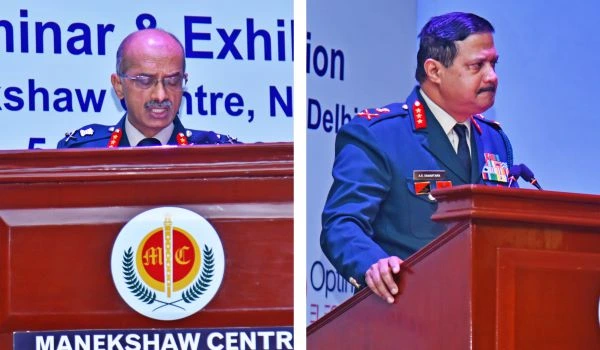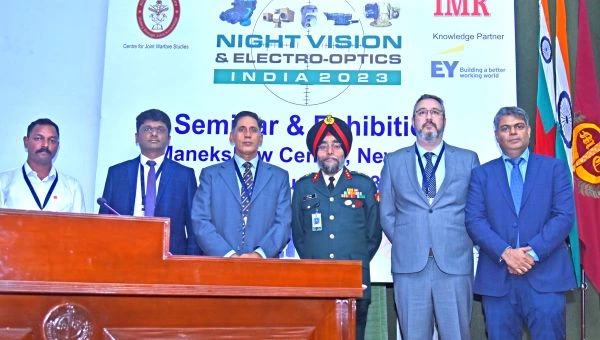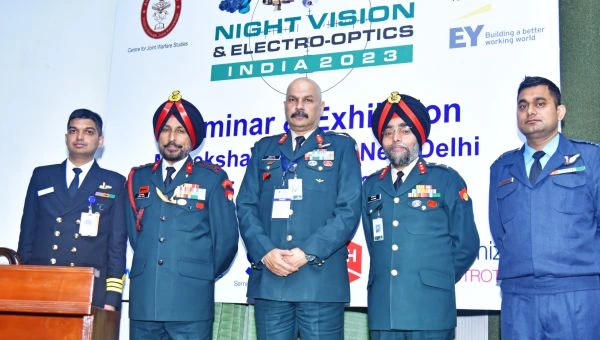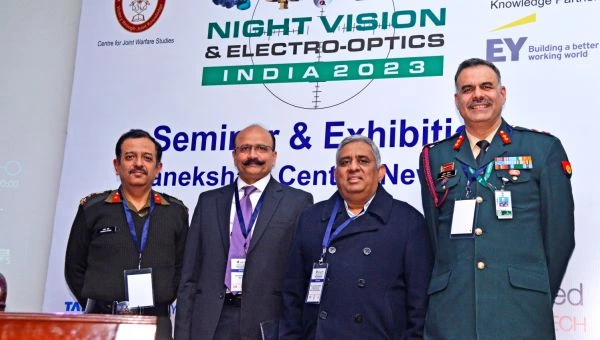

Col VN Shukla, VSM
The Centre For Joint Warfare Studies (CENJOWS) and Indian Military Review organised the Night Vision & Electro-optics India 2023 seminar and exhibition in New Delhi on 5 Jan 2023.
The aim of the seminar was to bring together all the stakeholders in discussing and resolving issues pertaining to building night vision capability of the Armed Forces. ‘Divyadrishti’ as highlighted by Kautilya is equally applicable in today’s scenario for battlefield transparency in land, sea and air in all wars for triumphing the observation part of OODA loop. The Night Vision and Optronics devices provide the capability to the soldier for finding, fixing and finishing activities of the war fighters and enhance their observation, detection, identification and killing capabilities. Unprecedented proliferation of dual use technology facilitates innovative employment of night vision devices. With mobiles in use, now each and every citizen has turned into intelligence sensors. The focus areas of the warfare these days include large borders and huge weather challenges; therefore whoever controls the night will win the battle. The night vision devices are true force multipliers and need to focus on mass effect not the forces. With the changes in technology bringing in Artificial Intelligence for imagery processing and see through armour and focus on obscurance – aerosol and active decoys, the focus on night vision devices will increase manifold in times to come. The users, private industry and DPSUs must come together to create an environment, which overcomes the procedural bottlenecks and ensures self sufficiency in this field, which will also be aligned with the Atmanirbhar Bharat vision.








Eminent speakers underscored the salience of situational awareness in the emerging Intelligence, Surveillance and Reconnaissance (ISR) matrix and how Atmanirbhar Bharat and Make in India initiatives are critical in major defence areas having potential for defence exports by India. There are 46 ongoing projects worth over Rs 47,000 crore, where the industry is engaged with the Indian Army. The Army Design Bureau has been energized as the lead agency together with the various directorates to take the initiatives ahead. The requirements for the night capability have been shared with the industry. Night fighting assumes added importance since surprise and deception are better achieved during the hours of darkness. CI/CT commitments demand constant vigil along the LC, LAC and in the hinterland.
Sizeable investment in this cutting edge technology area is essential and to address infiltration and enable military operations. Investments in border surveillance equipment, BFSR and weapon mounted sights is paramount. The need for II sights for short ranges and TI sights for longer ranges is inescapable. Night sights are being provisioned for frontline troops as per a phased roadmap. There is a need to indigenise EO sights with a realistic cost factor, incorporating latest technologies through a public private partnership. Industry must assist in evolution of service QRs based on emerging technologies, provisioning of simulators for modern training infrastructure, research and development efforts, explore fusion of II and TI technology, innovation of light weight equipment and compact power sources. There is a need to exploit the IDEX and TDF schemes, with accelerated timelines, with enhanced synergy between industry and users.
DRDO labs have provided several solutions for Electro Optics and there are many products under induction, to include weaponisation of HHTI, Project Dharashakti and Driver’s Night Sight. Recent advancements in II technology and digitised battlefield call for advanced EO System requirements (ie, range, field of view and recognition capabilities). There is a need to overcome challenges to empower our Armed Forces, so as to reduce weight and size of night vision devices for effective data and image fusion. The trends point towards Combat Goggles and future weapon systems, C4I2SR and exoskeletons. EO Systems under development include Optical Shields, Handheld Ground Penetrating Radar (HHGPR), Vehicle Mounted Ground Penetrating Radar (VMGPR) and Through Wall Imaging Radar (TWIR).




Major Issues Discussed in the Seminar
The seminar provided a platform for sharing visions, capabilities, challenges and solutions as follows:-
• The DRDO and industry highlighted their capabilities and the ability to produce innovative solutions, especially the following to meet the requirements of the forces:-
(I) Latest night vision technologies and challenges.
(ii) Infra Red (IR) detection for defence applications.
(iii) Products and solutions in Electro Optics.
(iv) Artificial Intelligence (AI) in surveillance.
(v) Contribution towards self reliance in thin films and night vision optics.
• The services highlighted their NVD and EO requirements, especially for Infantry, Artillery, AFVs and Army Aviation. The process of trials of NVDs by Directorate General of Capability Development, IHQ of MoD (Army) was also explained in detail for the benefit of the industry representatives.
• Challenges in border management at night were highlighted by the BSF representative.
Armed Forces Requirements
Infantry Requirements. The Infantry requires II+TI sights and devices for assault rifles and LMGs, TI sights for MMG, AGS, Snipers and 84 mm RL. A mix of PNVG, PNVB, HHTI and HHTI (UC) form part of these requirements. In times to come, the user seeks indigenisation of critical technologies (to include TI Sensors, Micro Channel Plates (MCP) and Fire Control System (FCS)) to improve technical thresholds (Figure of Merit (FoM), Graphene, AI), development of fusion technology (TI and II) and in house R&D by the production agencies.
Army Aviation Requirements. The Army Aviation projected the requirement of light weight, long lasting, all weather panoramic NVGs, with colour symbology, superimposing mission symbols on outer scenery with common Heads up Display (HUD) accessories for day and night flying and NVG simulators and dark rooms.
Mechanised Forces Requirements. The following requirements for AFVs were highlighted:-
(I) Combined day/night EO sights for NSVT 12.7 mm Gun operated remotely.
(ii) Head Mounted Displays – Real Time Zero Latency Video Feed – See Through Armour, Common Operational Picture for crew, Holistic Battlefield Management System (BMS) – integration with Identification of Friend and Foe (IFF)/Situational Awareness (SA), so as to attain 360 degree close hatch fighting capability in diverse operational situation and varied terrain.
(iii) Local situational awareness – automated processing with fusion technology.
(iv) Recce Troop – night enablement for 7.62 mm armament.
(v) Integration of EO Feed from three dimensional assets (smart sensors) for Beyond Line of Sight (BLOS) capability.
(vi) Technology induction – enhanced operational effective AFVs – Manned – Unmanned Teaming (MUMTs)/integrated surveillance and target systems.
(vii) Survivability – adaptive camouflage, Multi Spectral Camouflage Nets (MSCN).
Artillery Requirements. The Artillery and SATA requirements projected were as follows:-
(I) Ultra long range Electro-Optic Devices.
(ii) Higher resolution (Ultra High Definition (UHD), High Definition (HD)) for better identification capability.
(iii) Integration of multiple sensors (IR, Short Wave Infra Red (SWIR)/Medium Wave Infra Red (MWIR), LRF) for all weather surveillance.
(iv) Surveillance and targeting capability at higher ranges.
(v) AI enabled change detection, alarm system and auto generation of target profile.
(vi) All weather, more robust, light weight with better ergonomics.
(vii) More options of communication-wireless, High Definition Multimedia Interface (HDMI) and video.
(viii) Remote control at larger distances to save manpower.
(ix) Integration with battle surveillance system for online analysis.
Air Force Requirements. The Air Force needs night vision devices to meet its multiple operational roles. Laser Range Finders (LRF) are required for target range determination and target sighting. The following night vision device requirements were highlighted:-
(i) Be platform specific, with optimised weight suitable for platforms, meeting desired power and cooling requirements.
(ii) Have multi spectral capability.
(iii) Have light weight, compatibility, commonality, good visual acuity, all weather operations capability, mission recording and playback system for digital video recording and mission debrief tool.
(iv) Indigenisation is desired, so as to have reduced Turn Around Time (TAT) for repairs and reduced OEM dependency.
Indian Navy Requirements. The Navy projected the following night vision devices requirements for its maritime environment, ship borne, airborne and special naval operations:-
(i) Sensors and weapons to operate in marine environment under all weather conditions.
(ii) Special propagation conditions in terms of scattering, absorption and contrast.
(iii) All round 24×7 surveillance, detection and tracking.
(iv) Stabilisation – Roll/Pitch/Yaw.
(v) Military standards to withstand harsh marine environment.
(vi) Interface with ships systems (combat management system) for generating targeting solution for weapons.
(vii) Detection of all kinds of targets (to include surface ships, small crafts/submarine periscope, aircraft (Fighter/Maritime Reconnaissance (MR)/Helo/ (viii) Multi-spectral devices for assured performance under all conditions of propagation and target characteristics.
(ix) Integrated LRF to assess the range of target.
(x) Helmet mounted NVDs with four tube and four eyepiece configuration for better field of view. Additional features of ‘Auto Gating’ and ‘White Phosphorus Display’ were explained.
(xi) NV Monocular – NV capability for single eye with ocular for the other (Gen III and above).
Border Security Force. The border and battlefield night vision requirements projected include Thermal Weapon Sights, PNVDs, Weapon Alternative Processors (WAPs), IR Pan Tilt Zoom (PTZ) Cameras, Good Night Vision Pay Loads with Drones, Optical Target Locating System for detection of snipers, fog penetration radar devices and foliage penetration radar devices.
Industry Capabilities
The industry has the capability to meet most of the border and battlefield requirements.
The industry showcased its capability to make most of the products required by the services in the short term. Tata Advances Systems Limited (TASL) presented their products and solutions in EO Domain to include Remote Control Weapon System for 7.62 mm LMG, Stabilised EO solutions and uncooled TI based handheld systems.
Work is in the pipeline to meet the evolving and future needs of IAF.
For the Indian Navy, numerous key technologies to deliver the required specifications have already been harnessed. The industry was hopeful of meeting the evolving and the future Naval requirements and development of systems accordingly.
Sourcing of few components such as, Integrated Circuit (IC) tubes, are still ex import and involve large lead time. Atmanirbhar route could drive technological transformation for which Industry is ready to be the key enabler.
TASL presented their products and solutions on Sighting System for AFVs, Remote Control System for 12.7 mm guns and Stabilised EO System.
IRDE showcased Driver Night Sight for T-90 tank for fused technology based on uncooled TI technology and its Laser Fence.
TASL presented their products and solutions on Multi Long Range Surveillance Platforms – RAJAK ULR-25, Advanced System of LORROS, lightest in its class, detection of vehicles in excess of 32 km with high definition sensor version of it and Direct Fire Sight for Artillery Guns.
R&D Imperatives
In order to meet the medium and long term requirements of the services, especially through the Atmanirbhar route, adequate R&D needs to be undertaken, so as to meet these needs indigenously.
R&D in futuristic technologies needs to be funded and the pace needs to be accelerated.
The development of NVG simulators is inescapable and needs to be progressed expeditiously.
Joint ventures for the current technology and future upgrades are essential. IRDE may transfer the existing capabilities on ToT to private industry and focus on futuristic technologies. OEM mandated production and repair procedure need to be replicated. Strong R&D base and indigenous technology are essential. Training on simulators and live/ sectionised equipment is essential to improve skill sets.
There is a need to combine means for enhancing surveillance and get the latest technology either developed in house or by ToT from other countries.
Integrated capability development plan is essential, wherein, all common equipment for border and battlefield surveillance (including for military and CAPF) needs to be procured by one service, duly considering commonality and standardization, which will lead to cost cutting.
Key Takeaways
Salient takeaways which emerged during the course of the seminar are as follows:-
• The Indian Industry, DRDO and PSUs have the desired capability to meet most of the current requirements of the services, which needs to be exploited, especially the IRDE capabilities for Electro Optics solutions. Few gaps in capabilities need to be addressed in a synergised manner with participation of DRDO and Private Industry together, especially in areas of multi spectral fusion, miniaturization, autonomous functioning, long battery life and integration with command and control elements using AI.
• The Atmanirbhar push demands handholding of the Private Industry, which must be encouraged by providing access to in-service equipment/assets and futuristic requirements need to be shared to find innovative solutions.
• The users essentially desire equipment, which are affordable, adaptable, have ability to be absorbed into existing systems, with modularity, replaceability and repairability. Although Army Design Bureau and various directorates have spelt out the Army’s night vision equipment requirements, these need to be reviewed periodically on emergence of new technologies. The Air Force and Navy too need to regularly share their night vision equipment requirements. The user must formulate realistic GSQRs, based on leading edge technologies to allow faster growth and assist the forces in acquiring the latest equipment with spiral development approach. There is a need for infusion of investment and technology at all levels and greater synergy between all the stake holders. Such synergy and interaction will help demonstrate equipment on offer, share DRDO/OFB/Private Labs for testing and refinement and sharing IP rights to accelerate R&D.
• Sources of some of the critical equipment and spares (such as TI Sensors, Micro Channel Plates and Fire Control System as still ex-import and involve a large lead time. Therefore, indigenization of such critical technology is essential. Following recommendations were made to promote indigenization of such technology:-
(i) Realisation of the timelines in Positive Indigenization Lists (PIL).
(ii) Import of defence equipment to be done only as an exception.
(iii) Encouragement to Indian MSMEs by providing regular incentives.
(iv) Making the military infrastructure available to the industry for testing.
• The future needs demand improvement of technical threshold (FoM, Grephene, AI), fusion of II and TI technology, vision devices, surveillance devices, miniaturization (smaller and lighter devices), loiter munitions equipped with night vision capabilities, to out range the adversary (in detection, identification and recognition fields), cryogenic cooling technology, rearward streaming of every input and its utilization in real time and integration of Geo-referencing/Geo-fencing in night vision devices. The futuristic night vision technology will comprise of enhanced and dual sensor night vision devices for which continuous research and in house R&D by the production agencies are key. The evolving night vision technology for platforms needs to be based on affordability, ability to get absorbed into the existing and futuristic systems, durability, wireless technology, image compression, image fusion to facilitate provisioning of realistic images to the users. Sizeable investment in cutting edge technology and dual use technology development is essential through effective public private partnership and may help in optimum evolution and utilization of latest technology. The Private Industry needs to be encouraged, strengthened and supported with enhanced and assured funding to meet these requirements. IDEX and TDF schemes and other innovations and initiatives need to be exploited to reap dividends.
• There is a need to have the optimum capability of de-camouflaging military objects by use of appropriate devices to achieve penetration through the camouflage. Use of technologies to overcome limitations of camouflage and weather, especially fog and foliage was highlighted by all the users and industry was asked to come up with innovative solutions.
• Night Vision Simulators and modern training infrastructure are needed by all the three services.
• Issues related to in house image processing algorithms, sharing of source code by indigenous vendors, indigenous content verification at the level of Army Design Bureau need to be resolved by the services.
• All stake holders need to meet the timelines stipulated in the procurement process. Existing payment processes are usually slow and need to be improved.
The Ministry of Defence should drive the night vision capabilities, associated GIS and network requirements through a tri-service/joint overarching philosophy and hand hold the industry.


















